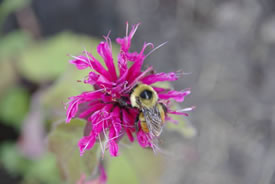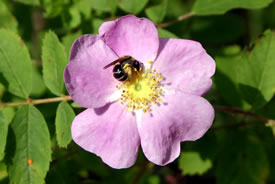Bees: Nature's busy farmers

Bee balm (Photo by NCC)
Pollinators are extremely important: not only are they responsible for one out of every three bites of food we eat, but they are vital in creating and maintaining the habitats and ecosystems that many animals rely on for food and shelter.
Bees are one such important pollinator. Pollination is among the bee's most important roles. This, in turn, results in flowers getting pollinated!
As a bee collects pollen from a flower, pollen from the stamens — the male reproductive organ of the flower — sticks to the hairs on the bee’s body. When the bee visits the next flower, some of this pollen is deposited onto the stigma — the female reproductive organ of the flower. This allows fertilization to occur, making it possible for fruit and seeds to develop.

Sweat bee on rose (Photo by Diana Bizecki Robson)
Many flowers need pollinators to reproduce and some have adapted over time to become especially attractive to bees. It is thought that certain species of bees prefer certain flower colours over others; however bees are typically drawn to plants with open or flat tubular flowers with lots of pollen and nectar. Bumble bees, for example, are thought to prefer blue or violet flowers, but still visit flowers of other colours. On the other hand, mason bees are important pollinators of fruit tree crops, like apple trees.
 Bees are excellent pollinators because most of their lives are spent collecting pollen, which they feed to their developing offspring. Many bee species, such as mason bees, are solitary, meaning that females nest alone or with their offspring. Solitary nesting bees create nests in long, narrow spaces like hollow plant stems, tunnels excavated by beetles in logs, snail shells, or snags in spaces between rocks.
Bees are excellent pollinators because most of their lives are spent collecting pollen, which they feed to their developing offspring. Many bee species, such as mason bees, are solitary, meaning that females nest alone or with their offspring. Solitary nesting bees create nests in long, narrow spaces like hollow plant stems, tunnels excavated by beetles in logs, snail shells, or snags in spaces between rocks.
Other bee species nest communally, where several females will share the nest. Still others, such as many species of bumble bee, are colonial and have elaborate social structures, class systems and divisions of labour within the colony, usually with a single queen and many workers.
Unfortunately, pollinators are experiencing population declines for many reasons including exposure to pesticides, disease, competition from invasive species and habitat loss. That’s why the 2.7 million acres (1.1 million hectares) protected by the Nature Conservancy of Canada across the country is so important. It provides vital habitat for these tiny workers.


